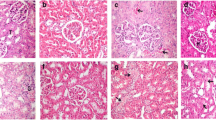Abstract—Ozone-photodynamic effects on tumor growth rate and oxidative modification of proteins in rat tissues were studied using a model of PA kidney carcinoma. It was shown that the developed experimental therapeutic method based on the joint parenteral intraperitoneal administration of an ozonated saline solution with a concentration of ozone in the ozone–oxygen mixture of 400 μg/L and a 0.3% solution of the Photosens photosensitizer intratumorally with the local action of light with a wavelength of 660 ± 10 nm for 10 min reduced the intensity of tumor growth. Normalization of the prooxidant/antioxidant balance in experimental animals was observed upon combined use of ozonated saline solution and photodynamic therapy.





Similar content being viewed by others
REFERENCES
V. V. Kuznetsov, Issled. Prakt. Med. 2 (4), 98 (2015).
A. B. Gapeyev, T. G. Shcherbatyuk, Biol. Membrany 37 (3), 163 (2020).
T. G. Shcherbatyuk, Nizhegorod. Med. Zh. 1, 52 (2003).
T. G. Shcherbatyuk, Fiziol. Zh. 54, 41 (2008).
T. G. Shcherbatyuk, V. D. Selemir, and E. S. Klintsova, RF Patent No. 2361590 (2007).
E. S. Knyazeva, T. G. Shcherbatyuk, and A. B. Gapeev, Vestn. Fizioter. Kurortol. 25, 37 (2019).
Ya. Buresh, O. Bureshova, and D. P. Houston, Methods and Basic Experiments in Studies on the Brain and Behavior (Vysshaya Shkola, Moscow, 1991) [in Russian].
N. V. Vdovina, E. S. Klintsova, and T. G. Shcherbatyuk, Sovrem. Tekhnol. Med. 2, 12 (2010).
T. G. Shcherbatyuk, I. A. Chernigina, E. S. Plekhanova, and A. B. Gapeev, Aktual. Vopr. Biol. Fiz. Khim. 4, 564 (2019).
S. N. Buranov, V. V. Gorokhov, V. I. Karelin, and V. D. Selemir, RF Patent No. RUS 2249445 (2003).
E. V. Yaroslavtseva-Isaeva, M. A. Kaplan, Yu. S. Romanko, et al., Ross. Bioterapevt. Zh. 2, 19 (2003).
K. E. Koptyaeva, A. A. Muzhikyan, Ya. A. Gushchin, et al., Lab. Zhivotn. Nauch. Issled. 2, 71 (2018).
Yu. I. Gubskii, I. F. Belenichev, E. L. Levitskii, et al., Sovrem. Probl. Toksikol. 8, 20 (2005).
A. V. Arutyunyan, E. E. Dubinina, and N. N. Zybina, Methods for Assessing Free Radical Oxidation and the Antioxidant System of the Body (IKF Foliant, St. Petersburg, 2000) [in Russian].
E. E. Dubinina, S. O. Burmistrov, D. A. Khodov, and I. S. Porotov, Vopr. Med. Khim. 41, 24 (1995).
E. I. Kuz’mina, A. S. Nelyubin, and M. K. Shchennikova, in Biochemistry and Biophysics of Microorganiosms (Gorky State Univ., Gorky, 1983), pp. 41–48 [in Russian].
E. V. Markova, Behavior and Immunity (NGPU, Novosibirsk, 2013) [in Russian].
B. L. Zharkoi, in Free Radicals, Antioxidants, and Animal Health (Voronezh State Univ.,Voronezh, 2004), pp. 36–40 [in Russian].
Yu. V. Nikitina, Extended Abstract of Candidate’s Dissertation in Biology (Nizhny Novgorod, 2009).
W. Girotti, J. Lipid Res. 39, 1529 (1998).
Yu. P. Kozlov, Free Radicals and Their Role in Normal and Patholgical Processes (Moscow State Univ., Moscow, 1973) [in Russian].
L. B. Dudnik, L. M. Viksna, A. Ya. Maiore, Vopr. Med. Khim. 46, 597 (2000).
M. M. Sozarukova, E. V. Proskurina, Yu. A. Vladimirov, Vestn. RGMU 1, 61 (2016).
Funding
The research was carried out with the financial support of the Russian Foundation for Basic Research, project no. 19-02-00667.
Author information
Authors and Affiliations
Corresponding author
Ethics declarations
CONFLICT OF INTEREST
The authors declare no conflict of interest.
COMPLIANCE WITH ETHICAL STANDARDS
All manipulations with animals were carried out in accordance with the recommendations established by the European Convention for the protection of vertebrates used for experimental and other scientific purposes (Strasbourg, 2006), and in accordance with the Helsinki Declaration on the humane treatment of animals (Edinburgh, 2000). The work was approved by the Local Ethics Committee of PRMU.
Additional information
Translated by E. Puchkov
Abbreviations: PDT, photodynamic therapy; OPS, ozonated physiological saline; OMP, oxidative modification of proteins; DNPH, dinitrophenylhydrazones; TBA, thiobarbituric acid; EB, exploratory behavior.
Rights and permissions
About this article
Cite this article
Shcherbatyuk, T.G., Zhukova (Plekhanova), E.S., Nikitina, J.V. et al. Oxidative Modification of Proteins in the Tissues of Rats with Growing Tumors under the Ozone-Photodynamic Treatment. BIOPHYSICS 65, 319–326 (2020). https://doi.org/10.1134/S0006350920020219
Received:
Revised:
Accepted:
Published:
Issue Date:
DOI: https://doi.org/10.1134/S0006350920020219




